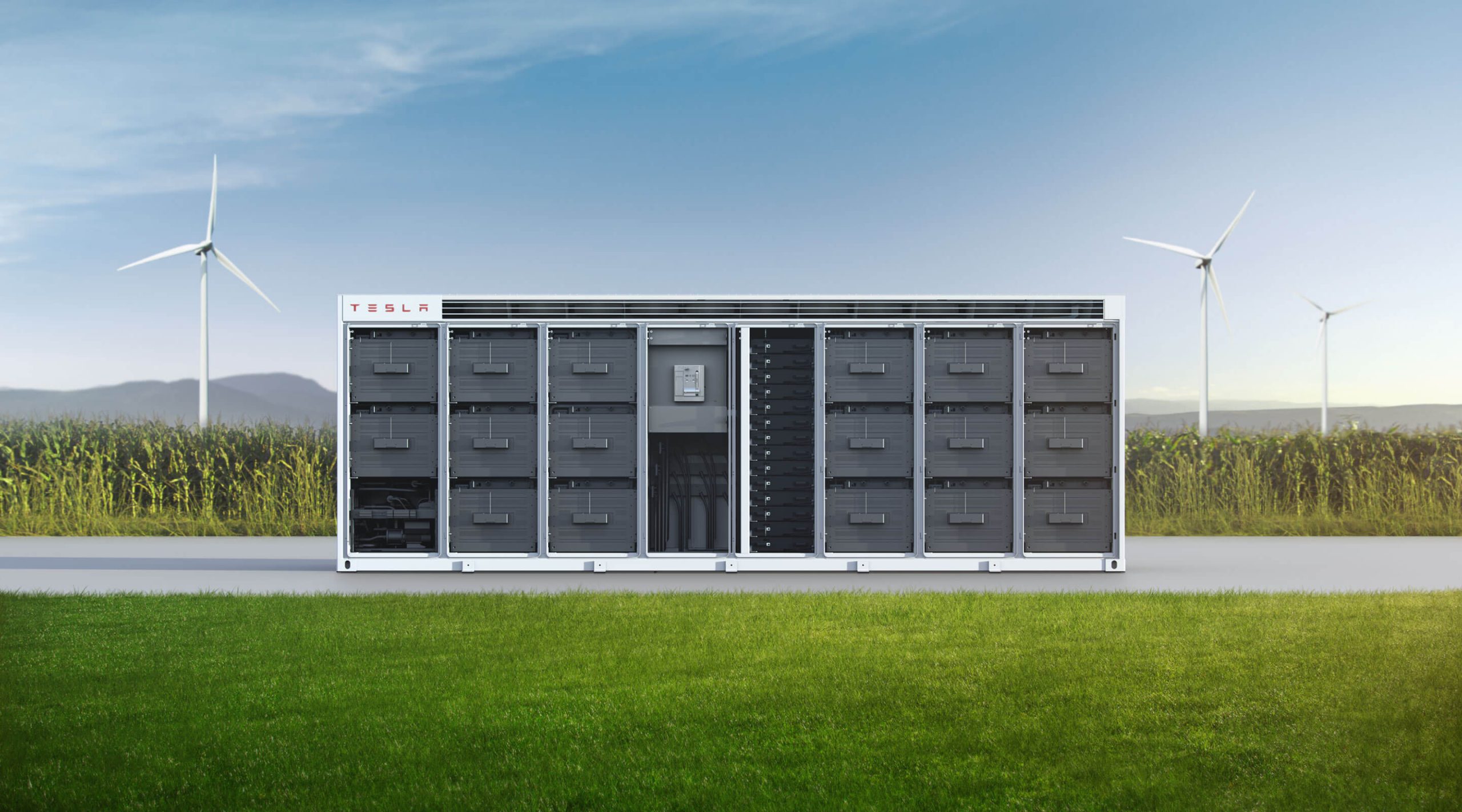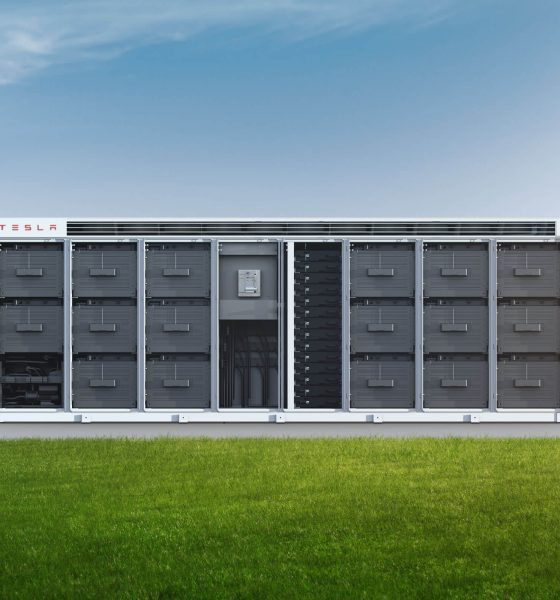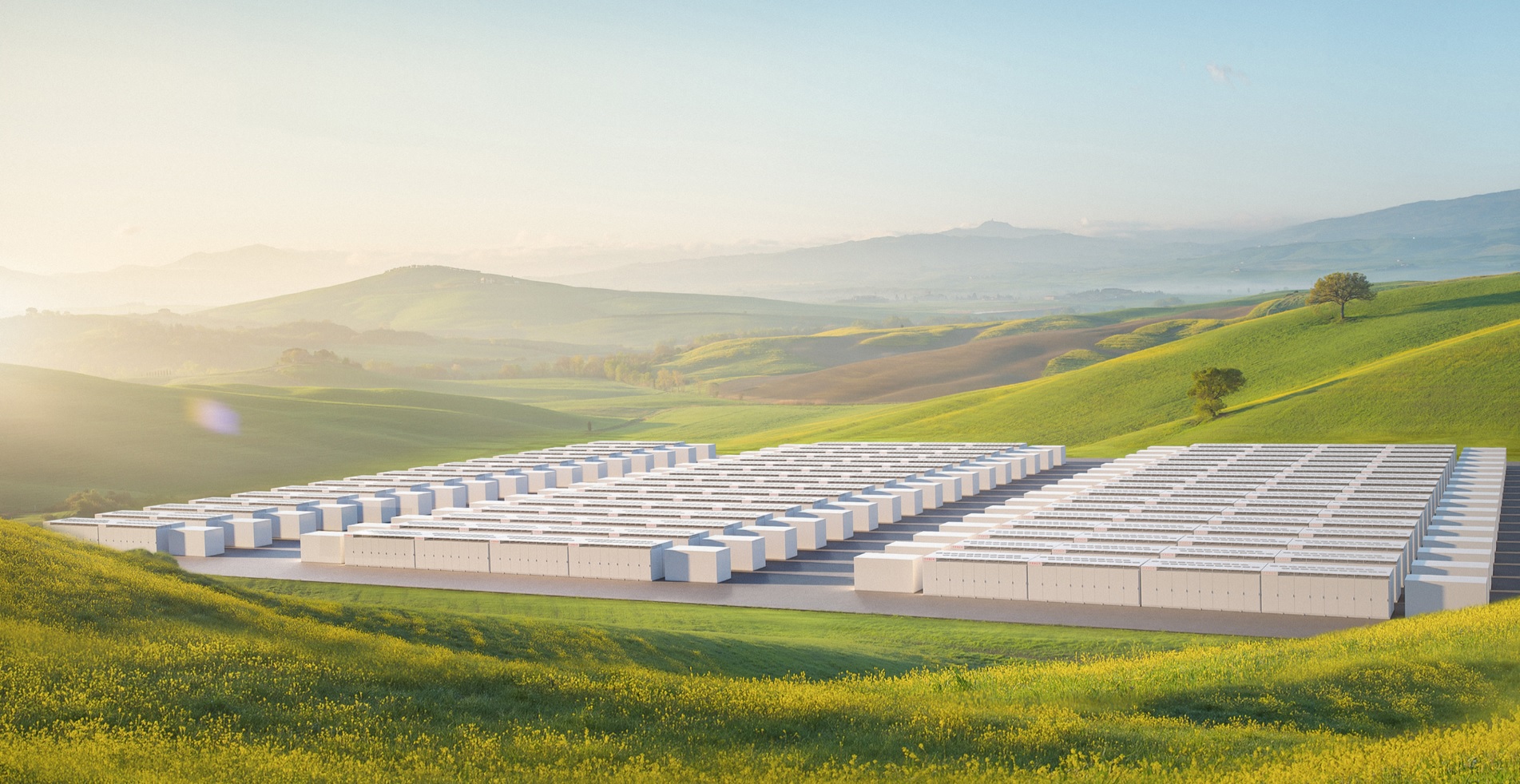

Energy
Tesla Megapack targets utilities with massive 3MWh plug ‘n play battery
After Tesla’s worldwide success with Powerpack battery grid installations, the company has now designed and engineered a new battery product called the Megapack made specifically for utility-scale projects. This larger battery pack has a 60% increase in energy density over the current Powerpack and boasts up to 3 megawatt hours (MWhs) of storage capacity per pack as a result. Megapacks also come completely assembled from Tesla’s factory for quick installation, altogether providing customers with savings in both cost and time.
Battery storage grids are important in the global energy grid’s transition to sustainable energy sources, and the Megapack’s massive capacity and scalability will make it an ideal choice for regions looking for a simple and cost-efficient ways to convert or support their current infrastructure. “Using Megapack, Tesla can deploy an emissions-free 250 MW, 1 GWh power plant in less than three months on a three-acre footprint – four times faster than a traditional fossil fuel power plant of that size,” Tesla stated in their announcement.
Along with an AC interface, the Megapack also includes DC-connectivity for solar grids, essentially giving it plug ‘n play capability for any type of power grid interface. Tesla’s Megapack product page further describes its “All-in-One-System” design:
“Every Megapack arrives pre-assembled and pre-tested in one enclosure from our Gigafactory—including battery modules, bi-directional inverters, a thermal management system, an AC main breaker and controls. No assembly is required, all you need to do is connect Megapack’s AC output to your site wiring,” Tesla detailed.

Tesla’s latest product is also very competitive compared to other utility power storage options available on the market. Thanks to its high-density energy storage capacity and modularity, the Megapack needs 40% less space and 10x fewer parts than comparable systems, according to data published on Tesla’s product page. This will bode well for areas with space constraints or simply desiring a smaller footprint for energy storage.
The Megapack will be utilized for an upcoming energy storage project hosted by Pacific Gas and Electric Company (PG&E) in Moss Landing, California once final approval from the state’s Public Utilities Commission is received. Under the project, Tesla’s battery-powered utility installation will store 182.5 megawatts of excess solar or wind energy to provide supplemental power during peak grid times for up to 4 hours at a time. It will take the place of natural gas “peaker” power plants, offering a much more efficient and clean alternative for Moss Landing’s energy needs.
The original Tesla Powerwall was launched in 2015 and has since been used for storage projects worldwide by scaling its 210 kWh capacity. In the UK, one of the country’s largest bus operators is using Powerpacks to charge its fleet of 9 all-electric buses and has received positive reviews from both riders and drivers. The lack of diesel fumes is both a notable and welcome change. In South Australia, Tesla’s Hornsdale Powerpack installation ultimately became the largest lithium-ion battery in the world. Interestingly enough, Volkswagen’s Electrify America also recently decided to purchase and install Tesla Powerpacks at over 100 of its charging stations, totaling a capacity of 350 kWh with 210 kW rapid charging compatibility.
Tesla’s full Megapack product announcement is provided below:
Introducing Megapack: Utility-Scale Energy Storage
Less than two years ago, Tesla built and installed the world’s largest lithium-ion battery in Hornsdale, South Australia, using Tesla Powerpack batteries. Since then, the facility saved nearly $40 million in its first year alone and helped to stabilize and balance the region’s unreliable grid.
Battery storage is transforming the global electric grid and is an increasingly important element of the world’s transition to sustainable energy. To match global demand for massive battery storage projects like Hornsdale, Tesla designed and engineered a new battery product specifically for utility-scale projects: Megapack.
Megapack significantly reduces the complexity of large-scale battery storage and provides an easy installation and connection process. Each Megapack comes from the factory fully-assembled with up to 3 megawatt hours (MWhs) of storage and 1.5 MW of inverter capacity, building on Powerpack’s engineering with an AC interface and 60% increase in energy density to achieve significant cost and time savings compared to other battery systems and traditional fossil fuel power plants. Using Megapack, Tesla can deploy an emissions-free 250 MW, 1 GWh power plant in less than three months on a three-acre footprint – four times faster than a traditional fossil fuel power plant of that size. Megapack can also be DC-connected directly to solar, creating seamless renewable energy plants.
For utility-size installations like the upcoming Moss Landing project in California with PG&E, Megapack will act as a sustainable alternative to natural gas “peaker” power plants. Peaker power plants fire up whenever the local utility grid can’t provide enough power to meet peak demand. They cost millions of dollars per day to operate and are some of the least efficient and dirtiest plants on the grid. Instead, a Megapack installation can use stored excess solar or wind energy to support the grid’s peak loads.
Tesla developed its own software in-house to monitor, control and monetize Megapack installations. All Megapacks connect to Powerhub, an advanced monitoring and control platform for large-scale utility projects and microgrids, and can also integrate with Autobidder, Tesla’s machine-learning platform for automated energy trading. Tesla customers have already used Autobidder to dispatch more than 100 GWh of energy in global electricity markets. And, just as Tesla vehicles benefit from continued software updates over time, Megapack continues to improve through a combination of over-the-air and server-based software updates.
As the world’s transition to sustainable energy continues to accelerate, the market for advanced battery storage solutions is growing rapidly. In the past year alone, we have installed more than 1 GWh of global storage capacity with our current storage products, Powerwall and Powerpack, bringing our total global footprint to more than 2 GWh of cumulative storage. With Megapack, this number will continue to accelerate exponentially in the coming years.
To learn more about Megapack and how our energy storage solutions for utilities and commercial customers are accelerating the transition to sustainable energy, visit tesla.com/megapack.

Cybertruck
Tesla updates Cybertruck owners about key Powershare feature

Tesla is updating Cybertruck owners on its timeline of a massive feature that has yet to ship: Powershare with Powerwall.
Powershare is a bidirectional charging feature exclusive to Cybertruck, which allows the vehicle’s battery to act as a portable power source for homes, appliances, tools, other EVs, and more. It was announced in late 2023 as part of Tesla’s push into vehicle-to-everything energy sharing, and acting as a giant portable charger is the main advantage, as it can provide backup power during outages.
Cybertruck’s Powershare system supports both vehicle-to-load (V2L) and vehicle-to-home (V2H), making it flexible and well-rounded for a variety of applications.
However, even though the feature was promised with Cybertruck, it has yet to be shipped to vehicles. Tesla communicated with owners through email recently regarding Powershare with Powerwall, which essentially has the pickup act as an extended battery.
Powerwall discharge would be prioritized before tapping into the truck’s larger pack.
However, Tesla is still working on getting the feature out to owners, an email said:
“We’re writing to let you know that the Powershare with Powerwall feature is still in development and is now scheduled for release in mid-2026.
This new release date gives us additional time to design and test this feature, ensuring its ability to communicate and optimize energy sharing between your vehicle and many configurations and generations of Powerwall. We are also using this time to develop additional Powershare features that will help us continue to accelerate the world’s transition to sustainable energy.”
Owners have expressed some real disappointment in Tesla’s continuous delays in releasing the feature, as it was expected to be released by late 2024, but now has been pushed back several times to mid-2026, according to the email.
Foundation Series Cybertruck buyers paid extra, expecting the feature to be rolled out with their vehicle upon pickup.
Cybertruck’s Lead Engineer, Wes Morrill, even commented on the holdup:
As a Cybertruck owner who also has Powerwall, I empathize with the disappointed comments.
To their credit, the team has delivered powershare functionality to Cybertruck customers who otherwise have no backup with development of the powershare gateway. As well as those with solar…
— Wes (@wmorrill3) December 12, 2025
He said that “it turned out to be much harder than anticipated to make powershare work seamlessly with existing Powerwalls through existing wall connectors. Two grid-forming devices need to negotiate who will form and who will follow, depending on the state of charge of each, and they need to do this without a network and through multiple generations of hardware, and test and validate this process through rigorous certifications to ensure grid safety.”
It’s nice to see the transparency, but it is justified for some Cybertruck owners to feel like they’ve been bait-and-switched.
Energy
Tesla starts hiring efforts for Texas Megafactory
Tesla’s Brookshire site is expected to produce 10,000 Megapacks annually, equal to 40 gigawatt hours of energy storage.

Tesla has officially begun hiring for its new $200 million Megafactory in Brookshire, Texas, a manufacturing hub expected to employ 1,500 people by 2028. The facility, which will build Tesla’s grid-scale Megapack batteries, is part of the company’s growing energy storage footprint.
Tesla’s hiring efforts for the Texas Megafactory are hinted at by the job openings currently active on the company’s Careers website.
Tesla’s Texas Megafactory
Tesla’s Brookshire site is expected to produce 10,000 Megapacks annually, equal to 40 gigawatt hours of energy storage, similar to the Lathrop Megafactory in California. Tesla’s Careers website currently lists over 30 job openings for the site, from engineers, welders, and project managers. Each of the openings is listed for Brookshire, Texas.
The company has leased two buildings in Empire West Business Park, with over $194 million in combined property and equipment investment. Tesla’s agreement with Waller County includes a 60% property tax abatement, contingent on meeting employment benchmarks: 375 jobs by 2026, 750 by 2027, and 1,500 by 2028, as noted in a report from the Houston Business Journal. Tesla is required to employ at least 1,500 workers in the facility through the rest of the 10-year abatement period.
Tesla’s clean energy boom
City officials have stated that Tesla’s arrival marks a turning point for the Texas city, as it highlights a shift from logistics to advanced clean energy manufacturing. Ramiro Bautista from Brookshire’s economic development office, highlighted this in a comment to the Journal.
“(Tesla) has great-paying jobs. Not just that, but the advanced manufacturing (and) clean energy is coming to the area,” he said. “So it’s not just your normal logistics manufacturing. This is advanced manufacturing coming to this area, and this brings a different type of job and investment into the local economy.”
Energy
Tesla and Samsung SDI in talks over new US battery storage deal: report
The update was related by industry sources and initially reported by South Korean news outlets.

Recent reports have suggested that Tesla and Samsung SDI are in talks over a potential partnership to supply batteries for large-scale energy storage systems (ESS).
The update was related by industry sources and initially reported by South Korean news outlets.
ESS batteries to be built at Samsung’s Indiana plant
As noted in a report from Korea JoongAng Daily, the demand for energy storage systems has been growing rapidly in North America, thanks in no small part to the surge in AI investments across numerous companies. With this in mind, Tesla has reportedly approached Samsung SDI about a potential battery supply deal.
The deal is reportedly worth over 3 trillion Korean won (approximately $2.11 billion) and will span three years, according to The Korea Global Economic Daily. A battery supply deal with Samsung SDI could make sense for Tesla as the company already has a grid-scale battery, the Megapack, which is perfect for industrial use. Samsung SDI could simply supply cells for the EV maker.
Production of the batteries would reportedly take place at Samsung SDI’s joint venture factory with Stellantis in Indiana, which is currently under construction. Samsung SDI recently announced plans to use part of that plant’s EV lines to produce cells for ESS, with a targeted capacity of 30 GWh by the end of next year.
Tesla and Samsung’s partnership
At present, only a handful of manufacturers, including Korea’s LG Energy Solution, Samsung SDI, SK On, and Japan’s Panasonic, are capable of producing energy storage-scale batteries domestically in the United States. A Samsung SDI official issued a comment about the matter, stating, “Nothing has been finalized regarding cooperation with Tesla.”
The possible energy storage system deal adds another layer to Tesla’s growing collaboration with Samsung, which is already in line as a partner in the upcoming production of Tesla’s AI5 and AI6 chips. Early sample manufacturing of the AI6 is expected to begin in South Korea, with mass production slated for Samsung’s Texas-based Taylor foundry when it starts operations.
The AI6 chip will power Tesla’s next wave of high-volume projects, including the Optimus humanoid robot and the autonomous Cybercab service. Musk has called the partnership with Samsung a “real collaboration,” adding that he personally plans to “walk the line” at the Taylor facility to speed up progress.








